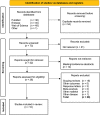Detection of cutaneous malignant melanoma by tape stripping of pigmented skin lesions - A systematic review
- PMID: 36973976
- PMCID: PMC10155806
- DOI: 10.1111/srt.13286
Detection of cutaneous malignant melanoma by tape stripping of pigmented skin lesions - A systematic review
Abstract
Background: Cutaneous malignant melanoma (MM) is potentially aggressive, and numerous clinically suspicious pigmented skin lesions are excised, causing unnecessary mutilation for patients at high healthcare costs, but without histopathological evidence of MM. The high number of excisions may be lowered by using more accurate diagnostics. Tape stripping (TS) of clinically suspicious lesions is a non-invasive diagnostic test of MM that can potentially lower the number needed to biopsy/excise.
Materials and methods: The aim is to determine the diagnostic accuracy of TS in detecting MM in clinically suspicious pigmented skin lesions. This systematic review following PRISMA guidelines searched PubMed, Web of Science, and Embase (September 2022) using melanoma combined with tape stripping, adhesive patch(es), pigmented lesion assay, or epidermal genetic information retrieval.
Results: Ten studies were included. Sensitivity ranged from 68.8% (95% confidence interval [CI] 51.5, 82.1) to 100% (95% CI 91.0, 100). Specificity ranged from 69.1% (95% CI 63.8, 74.0) to 100% (95% CI 78.5, 100). A pooled analysis of five studies testing the RNA markers LINC00518 and PRAME found a sensitivity of 86.9% (95% CI 81.7, 90.8) and a specificity of 82.4% (95% CI 80.8, 83.9).
Conclusion: Overall quality of studies was low, and the reliability of sensitivity and specificity is questionable. However, TS may supplement well-established diagnostic methods as pooled analysis of five studies indicates a moderate sensitivity. Future studies are needed to obtain more reliable data as independent studies with no conflict of interest.
Keywords: adhesive patch; diagnostic accuracy; epidermal genetic information retrieval; malignant melanoma; nevus; pigmented lesion assay; skin cancer; tape stripping.
© 2023 The Authors. Skin Research and Technology published by John Wiley & Sons Ltd.
Conflict of interest statement
None declared.
Figures
Similar articles
-
VivaScope® 1500 and 3000 systems for detecting and monitoring skin lesions: a systematic review and economic evaluation.Health Technol Assess. 2016 Jul;20(58):1-260. doi: 10.3310/hta20580. Health Technol Assess. 2016. PMID: 27483991 Free PMC article.
-
Neoadjuvant treatment for stage III and IV cutaneous melanoma.Cochrane Database Syst Rev. 2023 Jan 17;1(1):CD012974. doi: 10.1002/14651858.CD012974.pub2. Cochrane Database Syst Rev. 2023. PMID: 36648215 Free PMC article.
-
Intraoperative frozen section analysis for the diagnosis of early stage ovarian cancer in suspicious pelvic masses.Cochrane Database Syst Rev. 2016 Mar 1;3(3):CD010360. doi: 10.1002/14651858.CD010360.pub2. Cochrane Database Syst Rev. 2016. PMID: 26930463 Free PMC article.
-
Imaging modalities for the non-invasive diagnosis of endometriosis.Cochrane Database Syst Rev. 2016 Feb 26;2(2):CD009591. doi: 10.1002/14651858.CD009591.pub2. Cochrane Database Syst Rev. 2016. PMID: 26919512 Free PMC article.
-
Drugs for preventing postoperative nausea and vomiting in adults after general anaesthesia: a network meta-analysis.Cochrane Database Syst Rev. 2020 Oct 19;10(10):CD012859. doi: 10.1002/14651858.CD012859.pub2. Cochrane Database Syst Rev. 2020. PMID: 33075160 Free PMC article.
Cited by
-
LINC00518: a key player in tumor progression and clinical outcomes.Front Immunol. 2024 Jul 23;15:1419576. doi: 10.3389/fimmu.2024.1419576. eCollection 2024. Front Immunol. 2024. PMID: 39108268 Free PMC article. Review.
-
Challenges and considerations in melanoma diagnosis: Insights from 2 cases with negative pigmented lesion assay results.JAAD Case Rep. 2024 Jul 31;52:68-70. doi: 10.1016/j.jdcr.2024.07.010. eCollection 2024 Oct. JAAD Case Rep. 2024. PMID: 39286825 Free PMC article. No abstract available.
-
Cutaneous Oncology: Strategies for Melanoma Prevention, Diagnosis, and Therapy.Cancer Control. 2024 Jan-Dec;31:10732748241274978. doi: 10.1177/10732748241274978. Cancer Control. 2024. PMID: 39133519 Free PMC article. Review.
-
Non-invasive tools in the diagnosis of melanoma: Reflectance confocal microscopy and pigmented lesion assay.Skin Res Technol. 2023 Oct;29(10):e13476. doi: 10.1111/srt.13476. Skin Res Technol. 2023. PMID: 37881060 Free PMC article. No abstract available.
-
Mind the Gap: A Questionnaire on the Distance between Diagnostic Advances and Clinical Practice in Skin Cancer Treatment.Medicina (Kaunas). 2024 Jan 15;60(1):155. doi: 10.3390/medicina60010155. Medicina (Kaunas). 2024. PMID: 38256415 Free PMC article.
References
-
- Sung H, Jacques F, Rebecca LS, et al. Global cancer statistics 2020: GLOBOCAN Estimates of Incidence and Mortality Worldwide for 36 Cancers in 185 Countries. CA Cancer J Clin. 2021;71(3):209‐249. - PubMed
-
- Barber C, Boiko S. Tape stripping: investigational, diagnostic and therapeutic uses in dermatology. Clin Dermatol. 2022;40(4):355‐362. - PubMed
Publication types
MeSH terms
Substances
LinkOut - more resources
Full Text Sources
Medical




